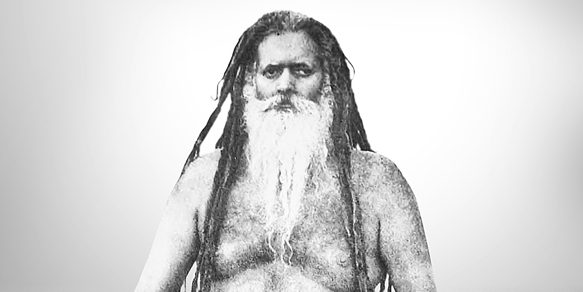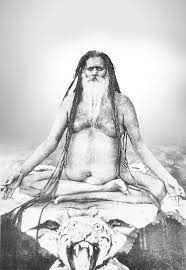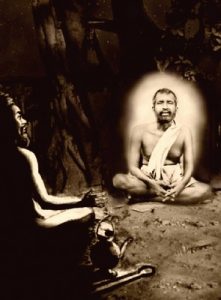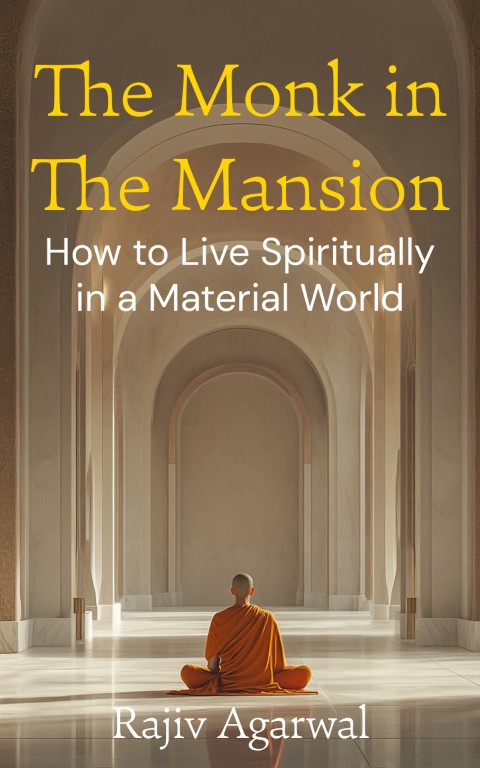
Totapuri – The Guru of Ramakrishna Paramhamsan
The life of Sri Ramakrishna Paramhamsa is filled with deep devotion, divine ecstasies, and mystical experiences, but one of the most significant moments in his journey was his encounter with Totapuri Maharaj. While most people associate Thakur Ramkrishna with Bhakti (devotion) and his intense love for Maa Kali, his spiritual evolution was not limited to the path of devotion alone. He also explored Jnana (knowledge), the non-dual path of Advaita Vedanta, under the strict guidance of Totapuri Baba, a wandering monk deeply rooted in the philosophy of formless, absolute consciousness.
Many people think of Sri Ramakrishna Paramhamsa as only a bhakta, a devotee who saw the divine in its personal form. But what they don’t realise is that he also went through the most rigorous Advaitic training, completely dissolving his personal identity into the infinite formless Brahman. And the person who led him into this experience was Totapuri, a fierce renunciate who had spent decades in deep meditation, mastering the art of non-dual realisation.
This meeting was not ordinary, it was a clash of two spiritual worlds. On one side, there was Sri Ramakrishna, whose entire being was immersed in devotion to Maa Kali, seeing her as the Divine Mother, real and alive. On the other side was Totapuri Maharaj, a man who had completely rejected all forms of deities, believing only in the formless, unchanging Brahman beyond all names and forms. The story of how these two powerful spiritual minds met, learned from each other, and transformed each other’s perspectives is one of the most fascinating aspects of Indian spiritual history.
It is often said that when the disciple is ready, the guru appears. And for Sri Ramakrishna Paramhamsa, Totapuri Baba came at the perfect time, just when he was ready to go beyond dualistic devotion and enter the highest state of Nirvikalpa Samadhi, where even the concept of “I” dissolves into the infinite. Without Totapuri, Ramkrishna Paramhans might have remained a great devotee of Kali, but with his guru’s help, he went beyond form and formlessness, realising the absolute unity of all existence.
Totapuri’s Background and Spiritual Journey

The Early Life of Totapuri Baba
Unlike Sri Ramakrishna Paramhamsa, whose early life is well documented, much of Totapuri Baba’s background remains a mystery. He was a Dashanami Sannyasi, belonging to the Advaita Vedanta tradition established by Adi Shankaracharya. His life followed the strict discipline of a Paramahamsa monk, someone who had renounced the material world completely, living without attachment, and dedicating every moment to the realisation of Brahman, the supreme consciousness.
From a young age, Totapuri Maharaj was trained in the scriptures of Vedanta, particularly the Upanishads and Brahma Sutras, which form the foundation of non-dual philosophy. But unlike scholars who merely read and debate the scriptures, Totapuri Baba lived by them. He didn’t just preach Advaita Vedanta, he became it, rejecting everything that wasn’t absolute, eternal, and beyond illusion.
His path was one of extreme renunciation. While devotional saints often carried images of their deities, performed rituals, and engaged in emotional worship, Totapuri Maharaj considered all these unnecessary distractions. He believed that Brahman was beyond emotions, beyond love, beyond any form. His only goal was to merge completely into this infinite reality, beyond birth and death, beyond joy and suffering.
Like many wandering monks of his time, Totapuri traveled across India, visiting holy places, meditating in remote forests, and guiding seekers who were serious about Vedantic realisation. He had trained under a great guru himself and had spent decades in deep meditation, perfecting the highest state of Nirvikalpa Samadhi, a state where all individual identity dissolves, and only the unmoving, eternal consciousness remains.
But for all his wisdom and discipline, Totapuri Maharaj had never encountered a spiritual personality like Sri Ramakrishna Paramhamsa before. When he arrived at Dakshineswar, he had no idea that he was about to meet a disciple who would not only reach the same Advaitic realisation but also teach him something in return.
Totapuri’s Arrival at Dakshineswar
Sometime in 1864, Totapuri Maharaj arrived at the Dakshineswar Kali Temple, a place where Sri Ramakrishna Paramhansa Dev had been serving as a priest and experiencing deep Bhakti ecstasies. Unlike other visitors, who came to seek blessings, Totapuri Baba came as a teacher, a guide who had mastered the highest truth of non-duality.
When Totapuri saw Sri Ramakrishna, he immediately recognised his spiritual potential. He could see that Ramakrishna was no ordinary devotee, his entire being was burning with divine longing. But there was one problem, Ramakrishna was still deeply attached to the form of Kali.
To Totapuri, this attachment was a limitation. From his Advaitic perspective, Brahman had no form, no name, no emotions. Worshiping Kali, a form of Shakti, the cosmic mother, was, in his eyes, a distraction from the ultimate truth. So he decided to help Sri Ramakrishna Paramhamsa cross the final barrier, to move beyond personal devotion and enter the realm of absolute formlessness.
At first, Ramakrishna Paramhansa Dev resisted. For him, Maa Kali was real, not just a concept. She was his Mother, his protector, his everything. How could he abandon her? But Totapuri Maharaj was firm. He told Ramakrishna that while devotion was a beautiful path, it was not the highest. The highest realisation was to see that everything, including Kali, was an illusion, and that only the unmoving, formless Brahman was real.
This was a huge challenge for Sri Ramakrishna Paramhansa. All his life, he had seen Maa Kali as his guiding force. But something inside him knew that Totapuri Baba was right, he was ready for the final step.
Totapuri’s View: Advaita as the Ultimate Truth
From the moment Totapuri Maharaj arrived at Dakshineswar, he saw Sri Ramakrishna Paramhans as a rare soul, someone capable of reaching the highest truth. But he also saw a problem: Ramakrishna’s deep attachment to Maa Kali.
For Totapuri, this attachment was a barrier. He believed that true enlightenment could only come when one transcended all forms, including personal gods like Kali, Krishna, or Shiva.
According to Advaita Vedanta, the world is an illusion (Maya), and everything, including religious rituals, emotions, and even devotion, is ultimately false. The only reality is Brahman, the infinite, formless, changeless consciousness.
Totapuri Baba lived by this belief. He had spent decades in deep meditation, renouncing everything worldly, including human relationships, emotions, and even compassion. To him, a personal God was just another illusion that had to be broken.
Ramakrishna’s View: The Divine Mother is Real
Sri Ramakrishna Paramhansa, however, did not see the world as an illusion. To him, Maa Kali was more real than anything else. He did not worship Kali out of blind faith, he had seen her, talked to her, and lived in her presence. She was not a concept; she was his Mother, the cosmic force that created and sustained everything.
For him, Bhakti (devotion) was not a lower path; it was the purest and most natural way to reach God. He often said, “Why do you need to dissolve into the formless, when you can experience God as your own Mother?”
This was the great clash between the guru of Ramkrishna Paramhans and his most extraordinary disciple.
- Totapuri Baba wanted Ramakrishna to give up Kali and realise Brahman.
- Ramakrishna Paramhansa believed that Kali and Brahman were not separate but one.
The Decision to Initiate Ramakrishna into Advaita Vedanta

After spending some time with Ramakrishna Paramhans, Totapuri Maharaj realised that he had found a disciple who was truly ready for Nirvikalpa Samadhi. Despite his deep devotion, Ramakrishna was not attached to the world. He had already renounced everything, family, desires, ego. Now, he only needed to break his last attachment, the form of Kali.
So, Totapuri Baba decided to formally initiate Sri Ramakrishna Paramhamsa into the path of Advaita Vedanta. This was not an ordinary initiation, it was a direct transmission of non-dual wisdom, a process that usually took years, sometimes even lifetimes, to master. But Totapuri Maharaj sensed that Ramakrishna was not an ordinary seeker, he was a rare soul, ready to experience the highest state of consciousness.
The initiation would involve intense meditation and the direct cutting away of all mental concepts. Ramakrishna had already experienced divine visions, but now he had to go beyond visions, beyond gods, beyond emotions, into the pure, silent, infinite presence of Brahman.
What followed was one of the most extraordinary spiritual transformations in history, a moment where the guru of Ramkrishna Paramhans, Totapuri Maharaj, would witness something that even he had never seen before.
This was the beginning of Sri Ramakrishna’s final journey into Nirvikalpa Samadhi, an experience that would change not just him, but even Totapuri himself.
Ramakrishna’s Training in Advaita Vedanta
The Struggle to Let Go of Kali
When Totapuri Maharaj, the guru of Ramakrishna Paramhans, decided to initiate Sri Ramakrishna into Advaita Vedanta, he knew it wouldn’t be easy. Ramakrishna was already a highly evolved soul, but his devotion to Maa Kali was so deep that it had become his entire reality. For him, Kali was not just an idol or a concept, she was living, breathing, and ever-present.
But for Totapuri Baba, this was a limitation. From his perspective, true enlightenment meant going beyond all forms, emotions, and personal gods. To him, Kali, Krishna, Rama, all of them were illusions. The only thing that was real was Brahman, the formless, eternal, unchanging consciousness.
So the real challenge was, could Ramakrishna let go of his beloved Kali and experience the infinite formless Brahman?
At first, Ramakrishna resisted. He could not imagine a reality without Maa Kali. She had been his mother, his protector, and his entire world. How could he simply erase her from his mind?
Seeing this struggle, Totapuri Maharaj decided to take extreme measures. He told Ramakrishna, “Close your eyes and meditate on the formless Brahman. Do not allow any image to appear in your mind.”
Ramakrishna tried, but every time he closed his eyes, the image of Kali appeared. He couldn’t push her away, she was too real. It was as if she was standing before him, looking at him with love. He opened his eyes, frustrated.
“I can’t do it,” he told Totapuri Baba. “Mother is always there.”
Totapuri wasn’t one to give up easily. He picked up a small piece of glass and held it in front of Ramakrishna. “Use your mind like a sword,” he instructed. “Cut through the image of Kali.”
This was a shocking idea for Ramakrishna. How could he cut through the very mother he loved so deeply? But something inside him knew that this was the final step. With all his willpower, he visualised a sharp sword cutting through the form of Kali, and suddenly, everything disappeared.
In that instant, Ramakrishna went beyond form, beyond thought, beyond identity. He fell into a deep state of Nirvikalpa Samadhi, where there was no “I” or “you,” no god or devotee, only pure, infinite consciousness.
The State of Nirvikalpa Samadhi
As soon as Ramakrishna Paramhans broke through his last attachment, he lost all awareness of the external world. His body became still, his breathing slowed, and he entered Nirvikalpa Samadhi, the highest state of non-dual consciousness.
For Totapuri Maharaj, this was shocking. He had trained many disciples in Advaita Vedanta, but he had never seen someone enter Nirvikalpa Samadhi so effortlessly. Most seekers spend years, even lifetimes, struggling to reach this state, but Sri Ramakrishna Paramhamsa entered it as if he had been waiting for it all along.
Days passed, but Ramakrishna remained in deep samadhi, completely unaware of his surroundings. He had merged with Brahman. Nothing else existed for him. He did not eat, drink, or speak. It was as if he had left his body behind.
Totapuri Baba watched over him, growing more and more amazed. He had met many great yogis, but this was something extraordinary. Who was this man, who could so easily cross into the highest state of consciousness?
Finally, after three days, Totapuri had to intervene. He realised that if Ramakrishna stayed in this state any longer, his body would not survive. He took some water and poured it into Ramakrishna’s mouth, slowly bringing him back to normal awareness.
When Ramakrishna finally opened his eyes, he was not the same person anymore. He had seen the absolute truth. He had experienced the formless reality of Brahman, and yet, his heart still longed for Maa Kali. This was the paradox of his enlightenment, he had realised both form and formlessness as one.
Ramakrishna’s Realisation: The Unity of Bhakti and Jnana
For Totapuri Maharaj, Advaita Vedanta was the final truth. Once you realise Brahman, everything else becomes meaningless. But for Sri Ramakrishna Paramhansa, this was only part of the journey.
He now saw something that even Totapuri had not realised, that form and formlessness are not separate. The personal God and the impersonal Brahman are one and the same.
He explained it in a simple way:
“Brahman is like an infinite ocean. When it is still, it is the formless absolute. But when the waves rise, they become names and forms, Kali, Krishna, Shiva. But the waves and the ocean are the same. The personal and the impersonal are not two; they are one.”
This was a revolutionary realisation. Most spiritual seekers either follow devotion (Bhakti) or non-dual knowledge (Jnana), but Sri Ramakrishna Paramhamsa merged both.
He did not reject Maa Kali after his Advaitic realisation. Instead, he saw her in a new light, not just as a goddess but as Brahman itself, appearing in a form out of divine love.
This was something Totapuri Baba had never considered before. He had always believed that once you reach Brahman, all forms become meaningless. But Ramakrishna showed him that even in the world of form, Brahman is fully present.
Totapuri’s Own Transformation
The Guru Becomes the Student
After training Sri Ramakrishna Paramhansa, Totapuri Maharaj thought his work was done. He had taught Vedantic wisdom, and Ramakrishna had realised the highest state. But something strange happened, Totapuri himself began to change.
He had always seen himself as a pure Advaitin, detached from all worldly illusions. But Sri Ramakrishna’s love for Maa Kali made him question something deep within himself. Had he been too rigid in his beliefs? Was he missing something?
Totapuri’s Illness and the Power of Kali
Not long after, Totapuri Baba fell seriously ill. He had spent years practicing extreme austerities, denying his body, living in harsh conditions. But now, his body refused to listen to him. He was in pain, something he had never experienced before.
In desperation, he tried to meditate, but nothing worked. For the first time, he felt powerless.
Seeing his suffering, Sri Ramakrishna Paramhamsa smiled and said, “Why don’t you pray to Kali? She is the Divine Mother. She will take care of you.”
At first, Totapuri was offended. Pray to a form? Never! He had spent his entire life rejecting deities. But as the pain grew unbearable, something in him softened.
In a moment of surrender, Totapuri Maharaj looked at the idol of Kali in the Dakshineswar temple and, for the first time, felt something he had never felt before, love.
It is said that in that moment, he had a vision of Kali, just as Sri Ramakrishna Paramhamsa had seen her. He realised that the formless Brahman and the Divine Mother were not two, but one.
This was the biggest transformation of Totapuri Baba’s life. The man who had rejected Bhakti now saw its truth. The guru of Ramkrishna Paramhans had become the student, learning a lesson he had never expected.
Totapuri’s Departure
After this experience, Totapuri Maharaj left Dakshineswar. He had come as Sri Ramakrishna’s guru, but he left as his disciple in another way. His meeting with Ramakrishna Paramhansa had changed him forever.
He continued wandering, but now, he carried something new, a realisation that Brahman and Bhakti are not separate. And that, in the end, the formless and the form are just two expressions of the same divine reality.
The Impact of Totapuri’s Teachings on Ramakrishna
Breaking Boundaries: The Merging of Bhakti and Jnana
Before Totapuri Baba arrived at Dakshineswar, Sri Ramakrishna Paramhansa was already an enlightened soul in the path of Bhakti. His devotion to Maa Kali was so intense that he saw her as a living presence, a mother as real as any human being. But despite this deep realisation, he had never crossed into the realm of pure, formless consciousness, where all identities disappear, and only Brahman remains.
Totapuri Maharaj’s arrival changed everything.
Through strict Advaitic training, Totapuri Baba helped Ramakrishna Paramhans realise that God is not just a motherly figure, not just a divine form, but an infinite, unchanging reality beyond time and space. This was a major turning point in Ramakrishna’s spiritual journey.
But what makes this story even more fascinating is that Ramakrishna did not abandon Bhakti after realising Advaita. Instead, he merged the two paths, showing that devotion (Bhakti) and non-dual wisdom (Jnana) are not opposites, but two sides of the same truth.
Ramakrishna’s Unique Understanding of God
After his experience of Nirvikalpa Samadhi, Sri Ramakrishna Paramhamsa explained his realisation in a way that was both profound and simple:
“Brahman and Shakti are one. When the ocean is still, it is formless Brahman. But when there are waves, it is Shakti, the Divine Mother. The One has become two, and the two are always One.”
This insight was revolutionary because most spiritual traditions in India saw Bhakti (personal God worship) and Jnana (impersonal God realisation) as completely separate. Devotees often dismissed Vedanta as dry intellectualism, while Advaita followers saw Bhakti as emotional and naive. But Ramakrishna Paramhansa proved that both are equally valid paths.
This integration became the foundation of his teachings and later influenced Swami Vivekananda, who spread this idea across the world. Without Totapuri Maharaj’s influence, Ramakrishna might have remained a pure Bhakta, and the world might never have received this balanced understanding of spirituality.
How Ramakrishna Taught Advaita to His Disciples
Even though Sri Ramakrishna Paramhansa had realised the truth of Advaita, he did not impose it on everyone. He understood that each seeker had a unique path, and he taught them accordingly.
- For those inclined to Bhakti, he encouraged devotion to God in a personal form, whether as Kali, Krishna, Rama, or Jesus.
- For those drawn to Advaita, he taught them the truth of formless Brahman, guiding them into deep meditation.
- For those struggling between the two, he showed how the personal and the impersonal are not different, but the same divine reality.
One of his most famous disciples, Swami Vivekananda, was deeply influenced by this idea. Before meeting Sri Ramakrishna, Vivekananda (then Narendranath Dutta) was an intellectual who leaned towards Advaita Vedanta. But through Ramakrishna’s teachings, he learned to see the beauty of both Bhakti and Jnana, eventually carrying this message to the world.
The Final Days of Totapuri and His Ultimate Realisation
Totapuri’s Wanderings After Dakshineswar
After training Sri Ramakrishna Paramhansa, Totapuri Maharaj left Dakshineswar and continued his wandering life. He had traveled all over India before, but now, something inside him had shifted.
For the first time in his life, he had experienced the power of Bhakti, something he had always dismissed. Ramakrishna Paramhansa had shown him that formless Brahman and the loving Mother were not separate, and this thought stayed with him as he continued his journey.
He visited various sacred places, meditating on the new understanding he had received. Though he remained an Advaitin, he was no longer rigid in his beliefs. He had seen something greater than philosophy, he had seen that the divine could manifest in countless ways.
The Death of Totapuri Maharaj
It is said that after this realisation, Totapuri Maharaj left his body in a state of bliss. Some accounts say that he walked into the Ganges, dissolving himself in the river, just as his consciousness had dissolved into Brahman. Others say he simply sat in meditation and never moved again.
Whatever the exact details, one thing is certain, Totapuri Baba had completed his journey.
The story of Totapuri and Ramakrishna Paramhansa remains one of the most powerful examples of how two different spiritual paths can merge into one truth.
- Without Totapuri, Ramakrishna might never have experienced Nirvikalpa Samadhi.
- Without Ramakrishna, Totapuri might never have understood the power of Bhakti.
Their meeting changed not just each other, but the entire spiritual landscape of India, paving the way for Swami Vivekananda’s message of religious unity and acceptance.

